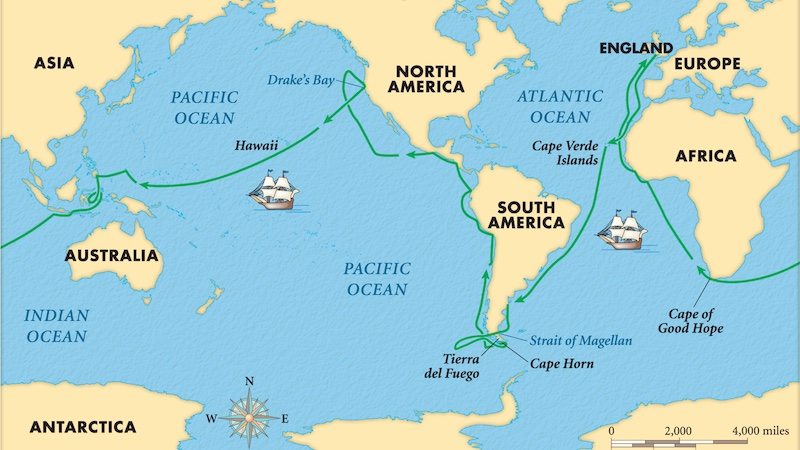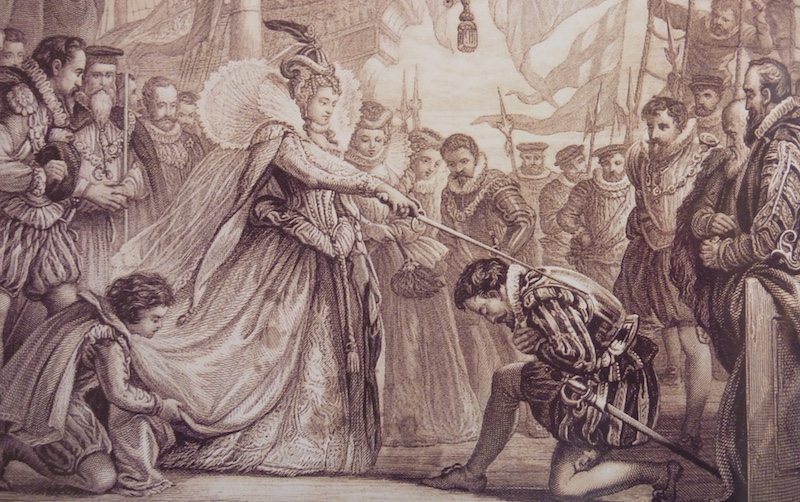Sir Francis Drake (1540–1597)
Episode #6 of the course “Europe’s greatest explorers”
Sir Francis Drake was an English navigator who played a significant role in worldwide trade and colonization. Born in Devon, England, as the son of a tenant farmer, Drake was introduced to sea life at a young age. He crossed the Atlantic on voyages to North America, the Caribbean, and Central America during his teens and 20s.
Queen Elizabeth I recruited Drake to be the first Englishman to circumnavigate the globe. Publically, his mission was to sail around South America directly to the Spice Islands, but privately, the queen ordered him to seek out a northern passage around America. England wanted to open its own trade routes without having to sail through Spanish-controlled waters. Elizabeth also secretly ordered Drake to plunder Spanish settlements along the Pacific coast of South and North America.
Francis Drake left Plymouth, England, in 1577 with five ships. The fleet quickly met with difficulties and endured hardships down the South American coast. By the time he reached the Strait of Magellan, only one ship remained. They traveled up the coast of Chile and Peru, sailing into the port at Lima completely unexpected. The Spanish sailors, who expected no ships in the region other than Spanish, were surprised into surrender, and Drake’s crew plundered massive riches.
Scholars are unsure exactly how far north along the North American coast Drake traveled, because his notes and charts have been lost. The Spanish confirmed him off modern-day California, but some remaining documents suggest Drake and his team made their way as far north as Oregon or the island chains off British Columbia.
Drake and his crew crossed the Pacific, landing for diplomacy and trade in the Philippines and Turnade. They reached the Moluccas (“Spice Islands”) in 1579 and took on a huge quantity of valuable spices. They proceeded around the Cape of Good Hope in Africa and returned to England in 1580. In order not to antagonize King Philip II of Spain, Queen Elizabeth ordered that there be no public celebration of Drake’s return and no publication about his travels or conquests.
The English called Drake a hero, but the Spanish knew him as a pirate. He plundered wealth from Spanish ships and ports that today would be valued at millions of dollars—gold and silver, jewels, pearls, and spices taken from Spanish holdings and delivered to the British treasury. It is said that King Philip placed a bounty on Drake; dead or alive, he was worth as much as $6.5 million in today’s money.
Queen Elizabeth knighted Francis Drake, and he went on to serve under Her Majesty’s command, plundering the Caribbean and South America for Spanish wealth. Sir Drake served as vice admiral of the British fleet in 1588, playing a crucial role in the English defeat of the Spanish Armada. Drake’s last mission to the Caribbean islands was met with disaster. The Spanish were prepared, and he failed to capture the port of Las Palmas and lost the Battle of San Juan. He died suddenly of dysentery off the coast of Panama, where he was buried at sea.
Recommended book
“The Secret Voyage of Sir Francis Drake: 1577-1580” by Samuel Bawlf
Share with friends



